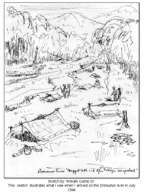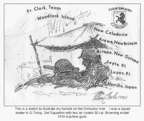| More about the bloody battle
Dog
Platoon at Driniumor River by
Bill Garbo
The battle of the Driniunor River in New
Guinea
June, July & August 1944
By: William Garbo Sr.
UPDATE:
8/20/12 See Remembering
Teddy at
the bottom just before the Photo album.
|
|
The Driniumor river flows North
out of the foothills of the Torricelli mountains into the Pacific Ocean at Aitape
on the northern coast of New Guinea, in a place called Papua or Dutch New Guinea.
The river is 30 to I00 yards wide and if the river is not rising, can easily be
crossed by walking over rocks and sandbars strewn with dead trees and brush while
avoiding the occasional deep hole,. When the water rises it is of short duration;
a muddy torrent boils down the river bed carrying trees and boulders with it.
This happens after a heavy cloud burst in the mountains which can be as often
as once a day
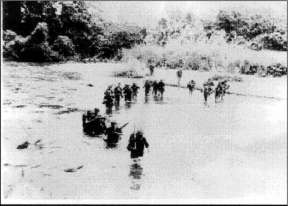 G-Troop crossing the Driniumor river from the West side.
This photo is looking South; up river. Aitape New Guinea July , 1944.
G-Troop crossing the Driniumor river from the West side.
This photo is looking South; up river. Aitape New Guinea July , 1944. | New
Guinea is the world's second largest island (after Greenland), 342,000 sq. mi.
in the South West Pacific Ocean, South of the Equator and North of Australia.
It is 1,500 miles long and 400 miles wide. Dajaja Peak (snow-covered) is the highest
point (16,503 feet) in the mountainous interior. The island is politically divided
between Indonesia, West and Papua New Guinea, East. Head hunting and cannibalism
are still practiced in some inaccessible regions. The inhabitants include Melanesians,
Papuans and Negritos. New Guinea is the most linguistically diverse region in
the world, with about 1,000 separate languages. | New
Guinea is covered with thick vegetation known as "jungle rain forest"
similar to the smaller islands of that general area of the South Pacific, notably
New Britain, Guadalcanal and the Bismarck Archipelago. With an annual rainfall
of 80 to 300 inches, (6' to 25') the jungle growth is massive within a few feet
of the ocean leaving a narrow and steep sand beach. When first viewed from the
| ocean, you marvel at
the beauty of this tropical paradise, the vegetation intermixed with coconut palms
swaying in the breeze looks beautiful and inviting however after landing there
this image changes. The jungle is characterized by giant hardwoods, which tower
two hundred feet into the air with trunks six and eight feet in diameter, flared
out at the base by great buttress roots. Among and beneath the trees thrive a
fantastic tangle of vines, creepers, ferns and brush, impenetrable even to the
eye for more than a few feet. Kunei grass 6 to 10 feet tall grows in a
thick maze
along the open sand bars of the rivers with its host of mites (carriers of scrub
typhus), | 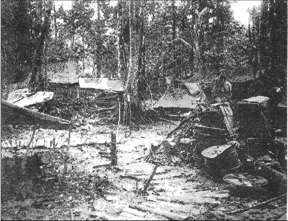
The 112th R C T headquarters on the Driniumor river at Afua General Cunningham's
command post, better known as " Baldy's CP" | lice
and giant spiders; the blades of grass are sharp enough to slice your arms and
legs if you try to walk through without using a machete to cut an opening. Exotic
birds inhabit the upper stories of the jungle growth while the Dodo bird walks
the jungle floor and never flies because of useless wings, the result of an evolutionary
change; its legs are powerful enough to kick a man to death when provoked; the
insect world permeates the sluggish whole scene in extraordinary sizes and varieties:
ants whose
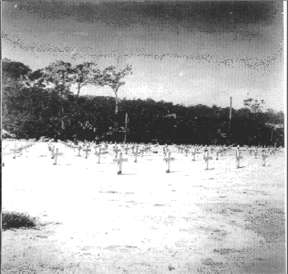 This is a picture of the cemetery on the beach at Aitape.
Photo taken by Edwin Boger from North Dakota (member of G-troop 112th Cav.)
This is a picture of the cemetery on the beach at Aitape.
Photo taken by Edwin Boger from North Dakota (member of G-troop 112th Cav.)
Ed Boger and I have exchanged photos
over the years and we try to get together every year at the reunion in Dallas. Bill
Garbo | bite feels
like a live cigarette against the flesh, improbable spiders, wasps three inches
long, scorpions and centipedes that sting thrive in the undergrowth. Insects fill
the evening air just before dark with a chorus of sounds so loud you can hear
nothing else. When darkness falls the noise of the insects continues for awhile
then stops abruptly as though ordered by some hidden authority bringing on an
eerie silence.. The animal kingdom is less numerous, represented by species of
large marsupial rats, a distant relative of the opossum, giant frogs, snakes and
lizards ranging in length from three inches to three feet and a few much larger
snakes of the constrictor type. Leeches fill the streams and must be removed from
your legs after wading through any water and some varieties are peculiar in that
they live in trees and drop upon the unwary passerby from
above sticking to the flesh, extracting blood in an instant. Anyone who has not
experienced it. After a rain shower steam rises from every man's wet mud. |
No air stirs-here, and the
hot humidity is beyond the imagination of soaked clothing as though you are on
fire. Rot lies everywhere just under the exotic lushness and it's foul smell fills
your nostrils. The ground is porous with decaying vegetation, emitting a sour,
unpleasant odor. Substantial-looking trees, rotten to the core, are likely to
topple over when leaned against, and great giants crash down unpredictably in
every rainstorm. Freshly -killed flesh begins to decompose in a matter of a few
hours with the aid of ever present maggots. Dampness, thick and heavy is everywhere
the result of regular
|
rains which give the forest its name; rain that is unbelievably
torrential at times, never ceasing altogether for more than
a few hours at a time. I was to find that most of the fighting
in New Guinea took place near the coast or beach (not too far
inland). New Guinea is one of the few places in the world that
is mainly unexplored, there are no roads except short ones built
hurriedly by the army engineers; foot paths, sometimes 8 to
10 feet wide used by the natives for thousands of years remain
everywhere; they are hard packed dirt, dusty when dry becoming
deep mud when walked on during and after a rain.)
Mosquitoes, bearers of dengue, and a dozen
lesser known fevers, inhabit the broad, deep swamps which are
drained inadequately by rivers.
The battle of the Driniumor river was to
be my first experience in combat; it took place in the rain
forest just described; a battle that, like the river will ebb
and flow for 45 days of unbelievable HELL.
|
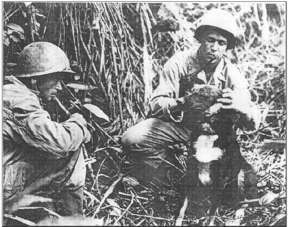 This is a photograph taken by the Associated
Press at the Driniumor river near Aitape. I am a corporal at
this time with the 26th War Dog platoon and I'm placing a message
pouch on my dog, Teddy's neck. Sgt. Robinson with the 26th Platoon
is watching. When the War Dog platoon arrived at the Driniumor
river we were attached to the various units that were already
on the river. I happened to be attached to the regiment of the
Dixie division which was made up of boys from Laurel, Mississippi,
my home town. I knew most of them. We took two dogs on each
patrol; one scout dog in the lead and one messenger dog. I joined
the 112th Cav. RCT in the second half of the battle.
This is a photograph taken by the Associated
Press at the Driniumor river near Aitape. I am a corporal at
this time with the 26th War Dog platoon and I'm placing a message
pouch on my dog, Teddy's neck. Sgt. Robinson with the 26th Platoon
is watching. When the War Dog platoon arrived at the Driniumor
river we were attached to the various units that were already
on the river. I happened to be attached to the regiment of the
Dixie division which was made up of boys from Laurel, Mississippi,
my home town. I knew most of them. We took two dogs on each
patrol; one scout dog in the lead and one messenger dog. I joined
the 112th Cav. RCT in the second half of the battle. One day when the river rose
after we crossed the river, my dog was swept away down the river
on his way back with a message. He was a powerful animal and
well trained and made it back to the C .P. in time to lay artillery
into a large concentration of Japanese troops.
|
|
Remembering Teddy
You may already know this but
we used dogs in New Guinea for scout duty and messenger service.
I trained 6 dogs in California and took two overseas; they were
trained for messenger service. My dog, Teddy (a Belgium Shepherd)
distinguished himself on several patrols and slept with me in
a foxhole. Each patrol had a scout dog and a messenger dog.
The photo was taken in Milne Bay, New Guinea by George Diller
from Erie Pennsylvania; he and I are the only ones left out
of the 26th war dog platoon. There were 30 men and 60 dogs in
the 26th War Dog Platoon. We were divided up into 4 man teams
and attached to the various units fighting from New Guinea to
Morotai, Mindanao, Leyte and Luzon.
|
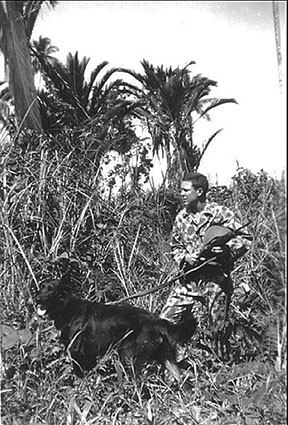
Teddy and Bill Garbo
Click the image for a larger
view |
Photo
Gallery
Click image for larger view
Sketches
of the battle area
Sketch by William Garbo Sr.
This illustrates
what I saw when I arrived on the Driniumor river in July 1944
(Click image
for a larger view) |
| My foxhole on the Driniumor river. I was squad
leader in G-Troop, 2nd Squadron with two air cooled 30 cal. Browning model 1919
machine guns. (Click image for a larger view) |
. 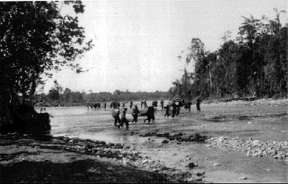 This is G-troop crossing the river; a 29 men combat patrol,
sometime in early July 1944, this photo was taken by John Davis G-troop who lives
in Abilene Texas. He left the war and became an engineer and I see him at the
Dallas reunions every year. Bill Garbo was somewhere in this patrol.
This is G-troop crossing the river; a 29 men combat patrol,
sometime in early July 1944, this photo was taken by John Davis G-troop who lives
in Abilene Texas. He left the war and became an engineer and I see him at the
Dallas reunions every year. Bill Garbo was somewhere in this patrol. |
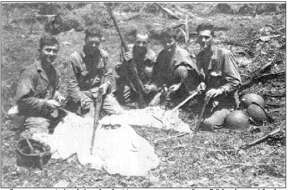 L to R: (Unknown), Andrew Jackson from Louisiana, (Unknown),
Cappy Fell from Iowa, and Sgt. Jones from Louisiana, on the Driniumor river in
a moment of quiet. We cleaned ourselves and our weapons during the day when possible.
Sometime in July 1944.
L to R: (Unknown), Andrew Jackson from Louisiana, (Unknown),
Cappy Fell from Iowa, and Sgt. Jones from Louisiana, on the Driniumor river in
a moment of quiet. We cleaned ourselves and our weapons during the day when possible.
Sometime in July 1944. |

Pug Wright from Abilene Texas (deceased) in background
looking at the camera and that's me (19 years old) to the left of the wonderful
New Guinea native with a big smile on his face. This picture was taken after the
battle in August 1944. We were actually sleeping on canvas cots and living in
squad tents (first class) near the beach at Aitape. The natives bathed in this
river; there was a foot bridge across the river covered with the steel matting
used for the airfield runway ( Tadji ). Nearby was a village which consisted of
a center court made of compacted mud (where dancing took place). The natives would
have Sing Sings on the weekends that lasted all night. As I lay on my cot covered
with a mosquito net I would wake up during the night by the sound of beating drums
and the singing from the native village. We saw no native women and children;
they were sent out to small islands off shore to live during the fighting. |
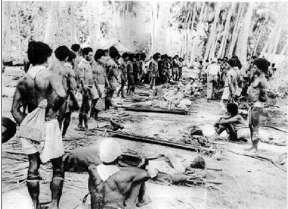
The natives were our saviors, they knew the jungle and guided us. They were somewhat
like our k-nines, they could sense the enemy before we could see him. We called
them the angels of New Guinea. They are preparing to evacuate our wounded and
K I A. Aitape New Guinea sometime in July 1944.
|

Send
Corrections, additions, and input to: WebMaster/Editor


Click
the star for
Site Map  .. ..
|
|





